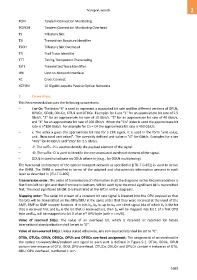Page 1103 - 5G Basics - Core Network Aspects
P. 1103
Transport aspects 2
TCM Tandem Connection Monitoring
TCMOH Tandem Connection Monitoring Overhead
TS Tributary Slot
TSI Transmitter Structure Identifier
TSOH Tributary Slot Overhead
TTI Trail Trace Identifier
TTT Timing Transparent Transcoding
TxTI Transmitted Trace Identifier
UNI User-to-Network Interface
XC Cross Connect
XGPON 10 Gigabit-capable Passive Optical Networks
5 Conventions
This Recommendation uses the following conventions:
– k or Cn: The index "k" is used to represent a supported bit rate and the different versions of OPUk,
OPUCn, ODUk, ODUCn, OTUk and OTUCn. Examples for k are "1" for an approximate bit rate of 2.5
Gbit/s, "2" for an approximate bit rate of 10 Gbit/s, "3" for an approximate bit rate of 40 Gbit/s,
and "4" for an approximate bit rate of 100 Gbit/s. When the "Cn" index is used the approximate bit
rate is n*100 Gbit/s. For example for Cn = C4 the approximate bit rate is 400 Gbit/s.
– x: The index x gives the approximate bit rate for a CBR signal. It is used in the form "unit value,
unit, [fractional unit value]". The currently defined unit value is "G" for Gbit/s. Examples for x are
"40G" for 40 Gbit/s and "2G5" for 2.5 Gbit/s.
– -P: The suffix -P is used to identify the payload element of the signal.
– -O: The suffix -O is used to identify the non-associated overhead element of the signal.
– ODUj: is used to indicate an ODUk where k>j (e.g., for ODUk multiplexing).
The functional architecture of the optical transport network as specified in [ITU-T G.872] is used to derive
the ONNI. The ONNI is specified in terms of the adapted and characteristic information present in each
layer as described in [ITU-T G.805].
Transmission order: The order of transmission of information in all the diagrams in this Recommendation is
first from left to right and then from top to bottom. Within each byte the most significant bit is transmitted
first. The most significant bit (bit 1) is illustrated at the left in all the diagrams.
Mapping order: The serial bit stream of a constant bit rate signal is inserted into the OPU payload so that
the bits will be transmitted on the OPU/ODU in the same order that they were received at the input of the
AMP, BMP or GMP mapper function. If m bits ba, bb, bc up to bm are client signal bits of which ba is the bit
that is received first and bm is the bit that is received last, then ba will be mapped into bit 1 of a first OPU
th
byte and bm will be mapped into bit 8 of an n OPU byte (with n = m/8).
Value of reserved bit(s): The value of an overhead bit, which is reserved or reserved for future
international standardization shall be set to "0".
Value of non-sourced bit(s): Unless stated otherwise, any non-sourced bits shall be set to "0".
OTUk, OTUCn, ODUk, ODUCn, OPUk and OPUCn overhead assignment: The assignment of an overhead in
the optical transport/data/payload unit signal to each part is defined in Figure 5-1. OTUk, ODUk, OPUk
contain one instance of OTU, ODU, OPU overhead. OTUCn, ODUCn and OPUCn contain n instances of OTU,
ODU, OPU overhead, numbered 1 to n.
1093

